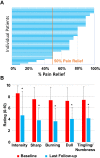Health-Care Utilization and Outcomes with 10 kHz Spinal Cord Stimulation for Chronic Refractory Pain
- PMID: 34880672
- PMCID: PMC8648088
- DOI: 10.2147/JPR.S306126
Health-Care Utilization and Outcomes with 10 kHz Spinal Cord Stimulation for Chronic Refractory Pain
Abstract
Background: Chronic pain is a common condition associated with decreased quality of life and increased health-care costs. Opioid analgesics are routinely used to treat chronic pain despite limited evidence of long-term efficacy. Spinal cord stimulation at a frequency of 10 kilohertz (10kHz-SCS) has been shown to be effective for treating chronic pain.
Objective: This study was conducted to evaluate the effects of 10kHz-SCS on patients' pain intensity, volume of pain interventions, and opioid intake in a real-world setting.
Study design: This study was a retrospective review of patient data.
Setting: The study was conducted at a single, community-based clinic.
Methods: Outcomes including pain relief, quality of life, opioid intake, and rate of health-care usage were evaluated using data from patients who were implanted with a 10kHz-SCS device to treat chronic pain. These outcomes were then compared for the pre- and post-implant periods.
Results: A total of 47 patients with a mean follow-up duration of 15.6 ± 6.2 months were included in this analysis. Mean pain relief was 73 ± 22% and 89% were responders at the final follow-up visit. The rate of medical interventions fell from 3.48±3.05 per year before starting 10kHz-SCS to 0.49±1.16 per year afterward (P < 0.001). Of 30 patients with available opioid consumption data, 89% maintained or decreased their intake after implant.
Conclusion: Retrospective data from a single center, with minimal exclusion criteria shows clinically significant pain relief with 10kHz-SCS, accompanied by significant indirect benefits including stable or reduced opioid use and reduced interventional procedures.
Keywords: chronic pain; health care costs; opioid analgesics; pain management; spinal cord stimulation.
© 2021 Gupta et al.
Conflict of interest statement
This study was supported by an unrestricted grant from Nevro Corp. Dr. Mayank Gupta reports grants from Nevro Corp., during the conduct of the study; personal fees from Nevro Corp., outside the submitted work; Consultant-Self Advisory/Medical Board-Self Investigator-Self from Averitas Pharma, Consultant-Self Investigator-Self from US WorldMeds, Consultant-Self Investigator-Self from Nalu Medical, Consultant-Self Advisory/Medical Board-Self from Foundation Fusion Solutions, Consultant-Self Investigator-Self from SPR Therapeutics, Inc., during the conduct of the study. The authors report no other conflicts of interest in this work.
Figures





Similar articles
-
Retrospective Efficacy and Cost-Containment Assessment of 10 kHz Spinal Cord Stimulation (SCS) in Non-Surgical Refractory Back Pain Patients.J Pain Res. 2022 Nov 16;15:3589-3595. doi: 10.2147/JPR.S373873. eCollection 2022. J Pain Res. 2022. PMID: 36415659 Free PMC article.
-
Decreased Opioid Consumption and Durable Pain Relief in Patients Treated with 10 kHz SCS: A Retrospective Analysis of Outcomes from Single-Center.J Pain Res. 2021 Aug 24;14:2593-2600. doi: 10.2147/JPR.S312932. eCollection 2021. J Pain Res. 2021. PMID: 34466027 Free PMC article.
-
Retrospective Assessment of Salvage to 10 kHz Spinal Cord Stimulation (SCS) in Patients Who Failed Traditional SCS Therapy: RESCUE Study.J Pain Res. 2020 Nov 10;13:2861-2867. doi: 10.2147/JPR.S281749. eCollection 2020. J Pain Res. 2020. PMID: 33204147 Free PMC article.
-
10 kHz spinal cord stimulation for the treatment of chronic back and/or leg pain: Summary of clinical studies.SAGE Open Med. 2020 Aug 20;8:2050312120951369. doi: 10.1177/2050312120951369. eCollection 2020. SAGE Open Med. 2020. PMID: 32913650 Free PMC article. Review.
-
Pain relief and improvement in quality of life with 10 kHz SCS therapy: Summary of clinical evidence.CNS Neurosci Ther. 2020 Apr;26(4):403-415. doi: 10.1111/cns.13285. Epub 2020 Feb 22. CNS Neurosci Ther. 2020. PMID: 32087613 Free PMC article. Review.
Cited by
-
Pain, quality of life, and function in chronic intractable leg pain were substantially improved with 10kHz spinal cord stimulation in a multicentre European study.Eur Spine J. 2025 Apr 7. doi: 10.1007/s00586-025-08752-w. Online ahead of print. Eur Spine J. 2025. PMID: 40192770
-
Utilizing 10kHz Stimulation to Salvage a Failed Low Frequency Spinal Cord Stimulation Trial.Orthop Rev (Pavia). 2023 Jan 28;15:57624. doi: 10.52965/001c.57624. eCollection 2023. Orthop Rev (Pavia). 2023. PMID: 36776275 Free PMC article.
-
Research hotspots and trends on spinal cord stimulation for pain treatment: a two-decade bibliometric analysis.Front Neurosci. 2023 May 25;17:1158712. doi: 10.3389/fnins.2023.1158712. eCollection 2023. Front Neurosci. 2023. PMID: 37304039 Free PMC article.
-
Healthcare Utilization (HCU) Reduction with High-Frequency (10 kHz) Spinal Cord Stimulation (SCS) Therapy.Healthcare (Basel). 2024 Mar 29;12(7):745. doi: 10.3390/healthcare12070745. Healthcare (Basel). 2024. PMID: 38610166 Free PMC article.
References
-
- Institute of Medicine. Relieving pain in America: A blueprint for transforming prevention, care, education, and research. Washington, DC: The National Academies Press; 2011. - PubMed
-
- Schappert SM, Burt CW. Ambulatory care visits to physician offices, hospital outpatient departments, and emergency departments: United States, 2001-02. Vital Health Stat. 2006;13(159):1–66. - PubMed
LinkOut - more resources
Full Text Sources

